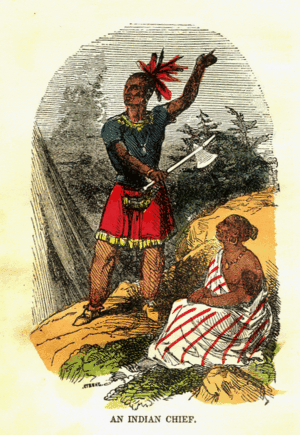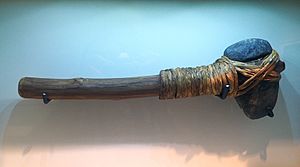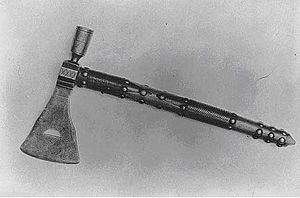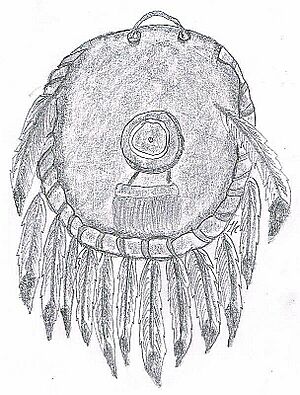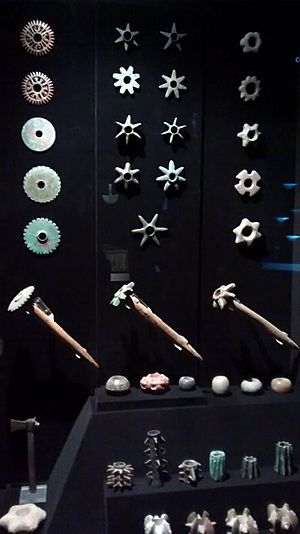Native American weaponry facts for kids
Imagine a time when people relied on their own skills and tools for survival and protection. Native American warriors used many different weapons. They needed these tools for hunting animals and for battles. Sometimes they fought other tribes, and later, European settlers.
Contents
Weapons in North America
Native Americans in what is now the United States and Canada used many kinds of weapons. We can sort them into five main types: weapons for hitting, cutting, or piercing, plus shields for defense, and special symbolic items.
Striking Weapons
These weapons were mostly for close-up fighting. Some could even be thrown.
- Stone clubs were made by attaching a stone to a wooden handle. Some clubs were carved from a single piece of stone. Common stones used were chert and flint. Many solid stone clubs were likely used for ceremonies, not just for battle.
- Wooden clubs were popular with woodland tribes. They were carved from strong wood like maple or oak. Early wooden clubs had a ball shape at the end. Later ones were sharpened, looking a bit like a wooden sword. Some even had a sharp stone piece stuck into the end, like an axe.
- The gunstock war club was mostly wood. It had a metal blade, like a spear point, at the end. This club was shaped like the stock of an 18th-century musket. Its design was inspired by European firearms. Perhaps Native Americans saw how settlers used their gun butts in fights. Or maybe they wanted to make other tribes think they had firearms too.
- The war hatchet looked a lot like a battle axe. It was also influenced by European axes. It had a sharp blade, made of iron or stone, attached to a handle.
- The pipe tomahawk was a special type of war hatchet. It could also be used as a smoking pipe! Tomahawks were great for close combat, like other striking weapons. They were also popular for throwing. The sharp edge was useful for skinning animals. Over time, the pipe tomahawk became more of a ceremonial item than a weapon.
Cutting Weapons
Native Americans used cutting weapons for both fighting and hunting. Tribes in North America preferred shorter blades. They did not use long cutting weapons like the swords common in Europe at that time.
- Knives were important tools for hunting and daily tasks, like skinning animals. Early knives had blades made of stone, bone, or deer antlers. These were fastened to wooden handles. Later, Native Americans also made knives from steel or iron, learning from European settlers. Some tribes had already found ways to use local copper and iron from meteorites to make weapons.
Piercing Weapons
Piercing weapons included both short-range and long-range tools. They were used for hunting and for fighting.
- Spears were used to thrust at enemies or animals. Spears had a short blade or tip, usually made of stone, attached to a long wooden handle. Some spears just had a sharpened wooden shaft without a stone tip. Spears could also be thrown from a distance.
- Lances were similar to spears but designed for use while riding a horse. Lances had longer shafts and tips than spears. This gave the rider more reach, allowing them to stab an enemy from horseback.
- The Atlatl, or spear-thrower, was a long-range weapon. Native Americans used it to throw spears, called darts, with great power and accuracy. An Atlatl is a hollowed-out shaft with a cup at the end. This cup holds a dart and helps push it forward. It extends the thrower's arm, giving more power to the throw. This made the dart fly much faster.
- Bows and arrows have been used by many cultures for thousands of years. An arrow is made like a small spear, with a small blade (arrow tip) on one end of a wooden shaft. Feathers are attached to the other end to help the arrow fly straight. Arrows are much smaller and lighter than spears. A bow is made of wood. The bowstring is often made from animal intestines, horse hair, or plant fibers. It is attached to each end of the wood.
Defensive Weapons
Some Native American tribes carried shields into battle for extra protection. These shields were usually made from leather stretched over a round wooden frame.
- War shields were mainly used to stop smaller flying objects like arrows. They could also redirect larger objects like spears. These shields were often carried by men on horseback. They were made from thick buffalo neck leather, sometimes with several layers for extra strength.
Symbolic Weapons
Many Native American weapons had a deeper, symbolic meaning.
- Medicine shields looked like war shields. However, their main purpose was to protect the carrier spiritually, not from physical attacks. Because they didn't need to stop physical blows, medicine shields were built much thinner and lighter than war shields. They were often decorated with symbols representing the spiritual strength of the person carrying them.
Weapons in Mesoamerica and South America
Indigenous peoples in Mesoamerica (like Mexico and Central America) and South America used many weapons similar to those in North America. These included spears, bows and arrows, atlatls, clubs, daggers, and shields. But they also had some unique weapons.
Aztec Weapons
- Mācuahuitl: This was a flat wooden staff or club with sharp obsidian blades along its edges. It could be used to make cutting wounds with the blades or to hit an opponent unconscious with the flat side. Some people compared it to a European broadsword, but others say it was a unique weapon. Both one-handed and two-handed versions were used. Spanish conquistadors said the mācuahuitl was so powerful it could cut off a person's head, or even a horse's head!
- Quauholōlli: This weapon was like a mace. It had a hard ball attached to the end of a wooden stick.
- Ichcahuīpīlli: This was thick, quilted armor. It was made of cotton sewn between layers of cloth. The armor was designed to protect the wearer from hits from mācuahuitl or other clubs, as well as arrows and atlatl darts.
Inca Weapons
- Bolas (Quechua: Liwi): These were weights attached to the ends of connected cords. The Inca army used them in battle.
- Slings (Quechua: Waraka): Slings were very important long-distance weapons for the Inca army. They were usually made of wool.
- Maces (Quechua: Champi): These weapons had a heavy object attached to the end of a wooden shaft. The head of the mace was often star-shaped and made of copper or bronze.


